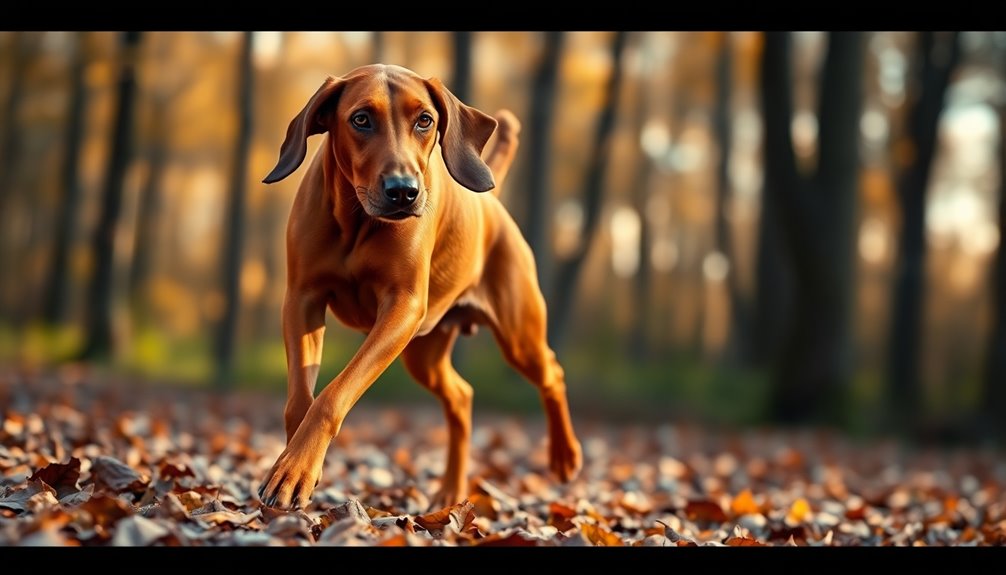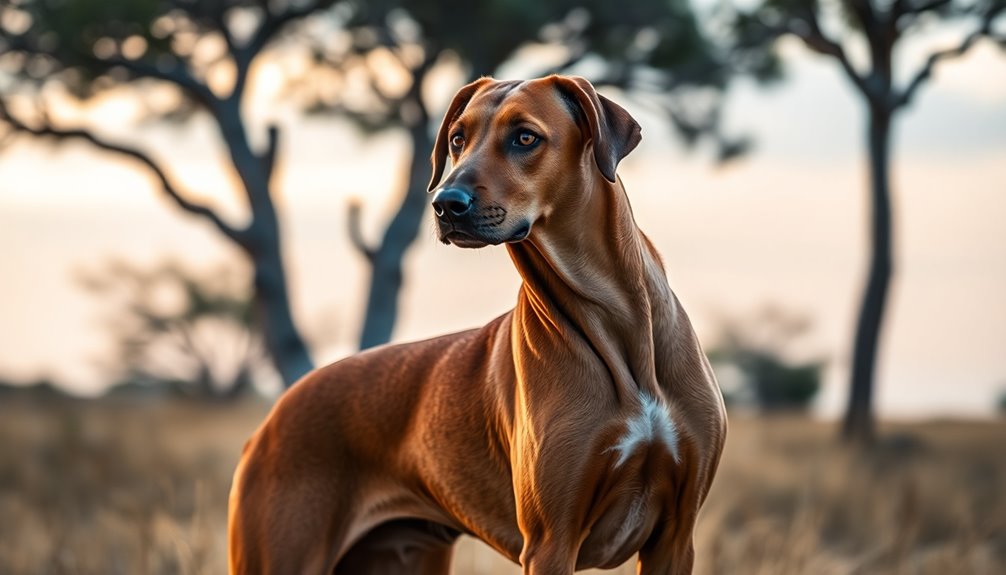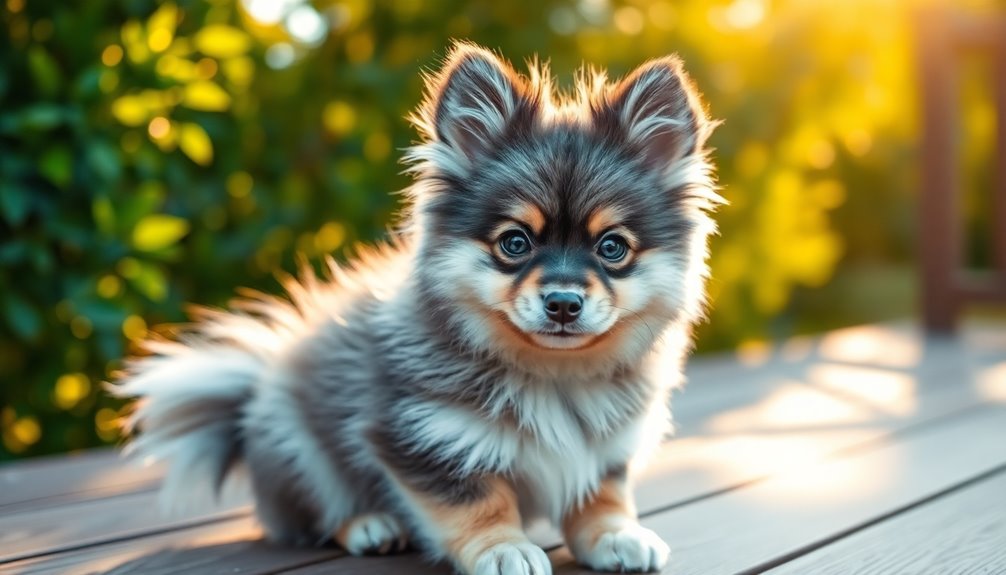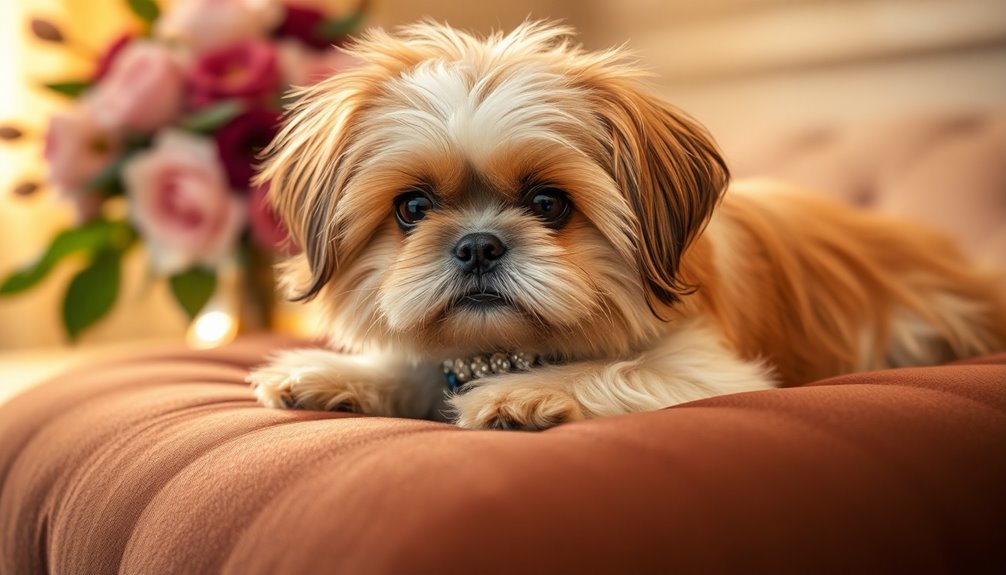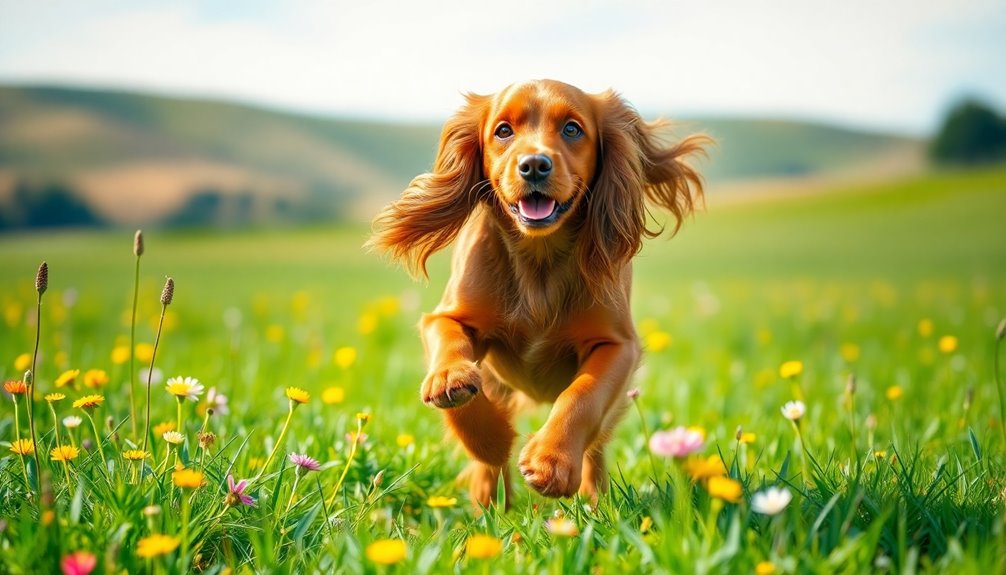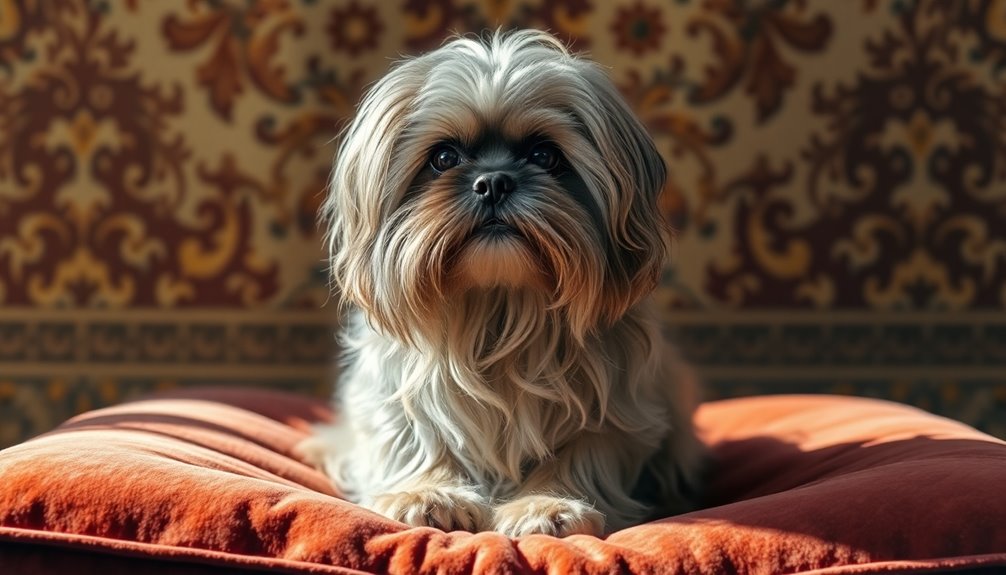If you're looking for a loyal and skilled hunter, the Redbone Coonhound is an excellent choice. Known for their impressive tracking abilities, these dogs can follow trails that are days or even weeks old. Their vibrant energy and friendly demeanor make them great companions, but they do require ample exercise to stay happy. With their distinct baying voice, they communicate effectively while hunting. Though they can be a bit stubborn at times, positive reinforcement in training works wonders. Explore more about their history and care to see why a Redbone Coonhound could be the perfect addition to your home.
Key Takeaways
- Redbone Coonhounds are known for their exceptional hunting skills, particularly in tracking and treeing game like raccoons and cougars.
- Their keen sense of smell allows them to detect trails that are days or even weeks old, showcasing their impressive tracking abilities.
- With a distinctive bay, they communicate effectively during hunts, making them reliable partners for hunters.
- Their friendly and adaptable temperament makes them not only skilled hunters but also loyal companions for families and individuals.
- Regular exercise and mental stimulation are essential to maintain their energy levels and hunting instincts effectively.
Introduction
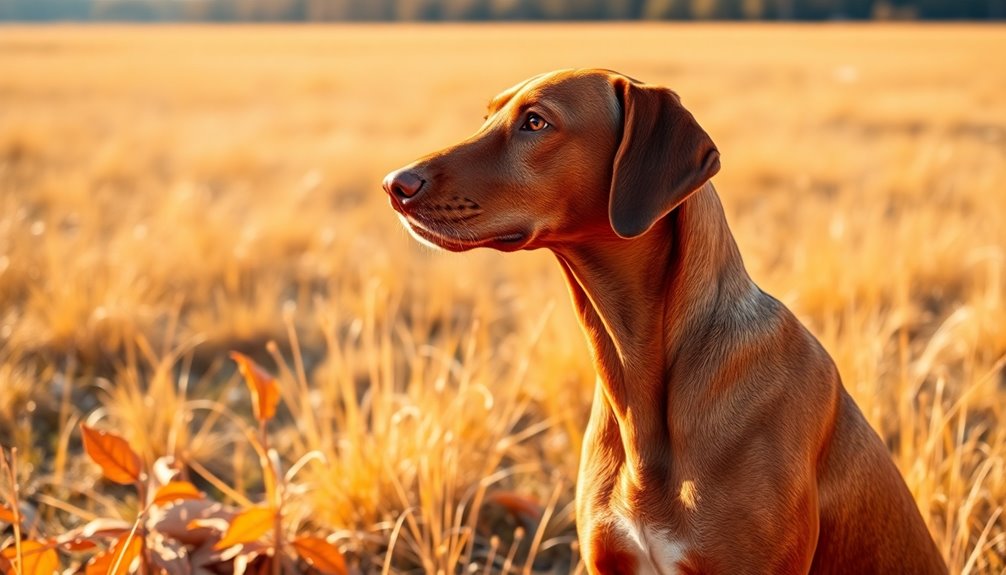
When you think of a loyal companion and skilled hunter, the Redbone Coonhound often comes to mind. This breed stands between 21 to 27 inches tall and typically weighs between 45 to 70 pounds. With a short, smooth, and shiny coat that boasts a rich red color, Redbones aren't only eye-catching but also easy to groom. Their clean, well-modeled heads and pleading brown eyes make them incredibly endearing.
Known for their friendly and even-tempered nature, these dogs adapt well to family life and are playful companions. Their intelligence makes them trainable, responding positively to patient guidance and consistent routines. While they possess moderate watchdog instincts, they aren't overly aggressive, making them great family pets. Additionally, they are intelligent dogs that benefit from mental stimulation and consistent training to thrive.
Redbone Coonhounds have a strong hunting drive, coming alive when game is near, but they can also be calm in everyday settings. They thrive in environments that provide ample space to roam and explore, needing regular exercise to stay healthy and happy.
With a lifespan of 12 to 15 years, these dogs are generally healthy, although some may face issues like hip dysplasia. A Redbone Coonhound can be a wonderful addition to your life.
History and Origin
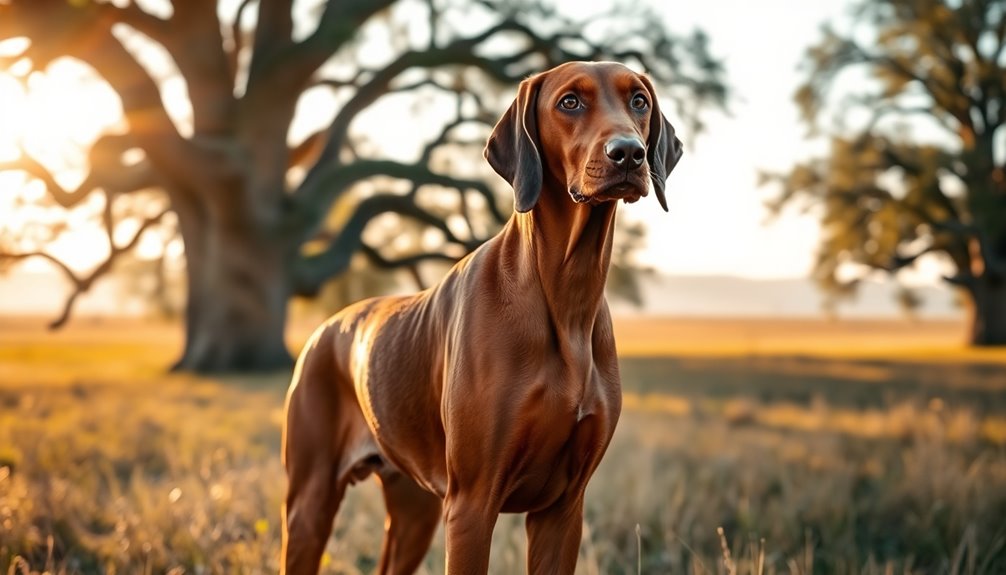
The Redbone Coonhound traces its roots back to the late 18th century when Scottish immigrants brought red foxhounds to the United States. Developed primarily in Georgia, these dogs were initially bred for hunting raccoons and other small game in the Southeastern landscape. Their strong instincts and adaptability made them exceptional treeing hunters, setting the foundation for the breed we know today. Known for their keen sense of smell, Redbones excel in tracking scents, enhancing their skills as hunting companions.
Where and when the breed originated
Originating in the late 18th century, the Redbone Coonhound has its roots in the red foxhounds brought to the United States by Scottish immigrants.
These early foxhounds were primarily developed in the Southeastern United States, especially in Georgia, where breeders began refining them for raccoon hunting. One of the key figures in this development was George F.L. Birdsong, who obtained a pack of these dogs in the 1840s and worked diligently to enhance their hunting traits.
Initially, these dogs were known as "Saddlebacks" due to their distinctive black saddle markings on a red background. However, selective breeding aimed to eliminate those markings, resulting in the solid red coat we associate with the breed today. While the Scottish foxhound served as the foundation, Irish Red Foxhounds and possibly Bloodhounds were also crossed in to improve the breed's speed and scenting ability.
Treeing Small Game
Throughout history, the Redbone Coonhound's exceptional treeing ability has made it a favorite among hunters targeting small game. These dogs excel at hunting creatures like raccoons, opossums, and squirrels, using their keen sense of smell to track trails that may be days or even weeks old.
Their strategy involves treeing the game, which allows you, the hunter, to take the shot once the target is located in the trees. Bred specifically for this purpose, Redbones are courageous and can handle larger prey too, ensuring they effectively tree even the most formidable animals. Their high energy level means they thrive on the excitement of the hunt.
Their agility and adaptability make them well-suited for various environments, from rugged mountains to marshy terrains. They can even swim to pursue game when necessary.
The treeing ability of the Redbone Coonhound is a result of careful breeding for superior tracking and persistence. These dogs can stay with treed game for hours, patiently awaiting your arrival.
However, it's crucial to provide them with proper training and socialization to ensure they develop into well-adjusted companions both in and out of the hunting field.
Physical Characteristics
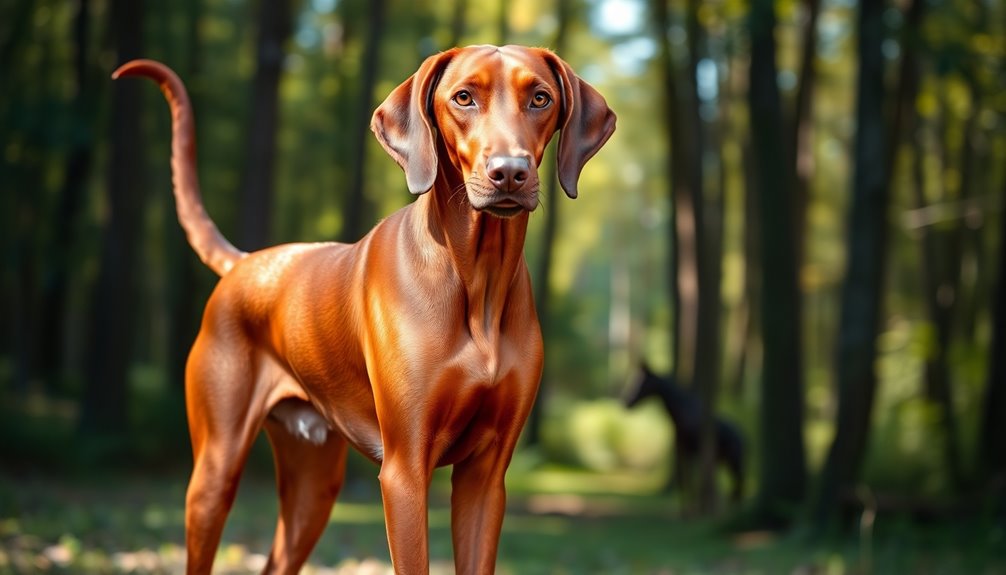
When you look at a Redbone Coonhound, you'll notice their lean, muscular build, standing between 21 to 27 inches tall and weighing 45 to 70 pounds. Their short, glossy coat shines in a rich, deep red, often accented by small white markings. You can't miss their long, droopy ears, which add to their distinctive and expressive appearance. These dogs are primarily hunters of small game like raccoons and squirrels, showcasing their agility and tracking skills.
Size, weight, and coat details
Have you ever wondered what makes the Redbone Coonhound such an impressive hunter? One key aspect is its size and weight. Males typically stand between 22 to 27 inches tall and weigh between 50 to 70 pounds, while females range from 21 to 26 inches in height and weigh between 45 to 65 pounds.
This lean, muscular build is designed for agility and endurance, essential traits for hunting. In addition to their physical prowess, they also require high exercise needs to maintain their energy levels, making them perfect companions for active owners.
Their short, smooth coat is another standout feature. It's glossy and coarse enough to provide protection during hunts, while the smooth feathering on their ears and lower legs adds a touch of elegance.
The coat is primarily a deep, solid red, often accented with small white markings on the chest, feet, or between the legs. You'll notice a dark muzzle and black masking around their eyes, adding to their striking appearance.
Importantly, the modern breed doesn't sport the black saddleback streaks seen in the past, favoring a uniform red tone instead.
With their impressive size, weight, and striking coat, Redbone Coonhounds aren't just beautiful; they're built for the hunt.
Long, Droopy Ears
The Redbone Coonhound's long, droopy ears are one of its most distinctive physical traits, perfectly complementing its impressive hunting abilities. These ears are formed by a cartilage-based flap covered in skin and fur, creating an ear structure that's both functional and unique.
The deep, L-shaped ear canal plays a crucial role in protecting the eardrum while efficiently collecting sound waves. This design allows sound to travel effectively to the middle ear, where it's amplified by tiny bones called ossicles. Dogs possess a more developed outer ear than humans, enhancing their ability to hear sounds that are imperceptible to us.
The mobility of the Redbone's ears enhances its ability to localize sounds, making it an exceptional hunter. When you see those ears stretch nearly to the end of the nose, you know they're tailored for superior hearing, especially at higher frequencies.
However, their floppy nature can increase the risk of ear infections, so regular ear cleaning is essential. You should be on the lookout for signs of irritation, like scratching or head shaking, which may indicate an infection.
Keeping your Coonhound's ears clean and dry will help maintain their health and ensure they stay sharp during those long hunting excursions.
Temperament and Personality
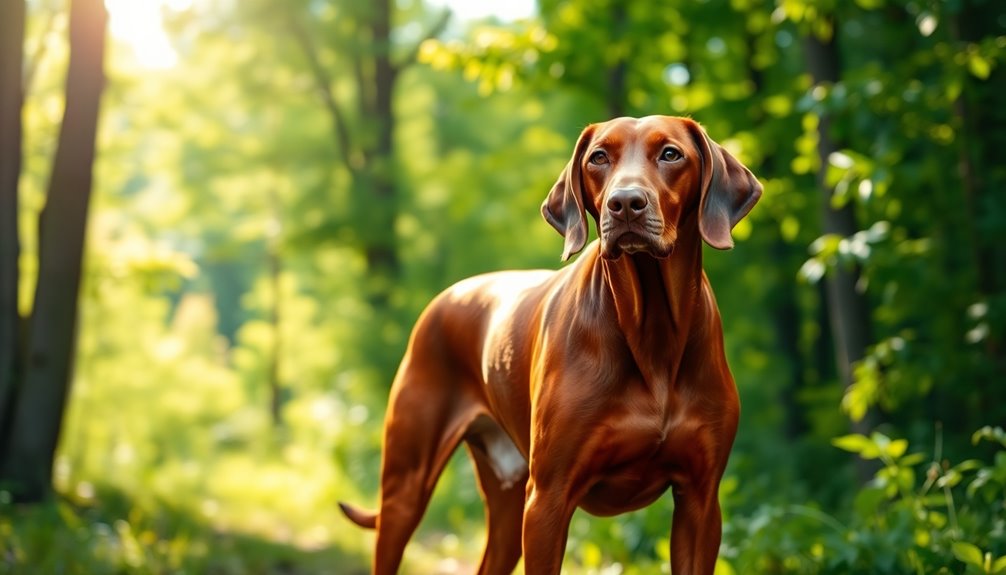
When you think about the Redbone Coonhound's temperament, you'll find they're affectionate and adaptable, making them a great fit for families, individuals, or even households with other pets. Their strong scent-tracking instincts shine during playtime or outings, showcasing their natural abilities. With the right attention and training, they can thrive in various environments while maintaining their playful and friendly nature. Their high energy levels require ample exercise and mental stimulation to keep them happy and prevent destructive behaviors.
Strong Scent-Tracking Instincts
Redbone Coonhound's remarkable scent-tracking instincts make it a standout among hunting breeds. With an excellent sense of smell, these dogs are legendary for their tracking abilities, especially when treeing raccoons.
But they don't stop there—they can also track larger game like bears and cougars across various terrains, from swamplands to rocky hills. Their muscular build, combined with high energy and stamina, allows them to engage in long tracking sessions without tiring easily. You'll find that their affectionate and intelligent nature shines through when they're on a scent trail.
While they might display a stubborn streak, they respond well to positive reinforcement, making training sessions enjoyable for both of you. During hunts, expect to hear their deep, melodious barks, as they communicate their finds. However, keep in mind that their strong prey drive can lead them to follow scents intensely, potentially ignoring other commands. Additionally, their skills can be further enhanced through proper training programs, ensuring efficient tracking during hunts.
When they're not on the job, they're laid back, but once it's time to hunt, their focus and determination come to the forefront, showcasing the incredible instincts that define the Redbone Coonhound.
Suitability for families, individuals, or other pets
Families and individuals looking for a loyal companion will find the Redbone Coonhound a great match. These dogs thrive in active households, especially those with older children or teenagers. While they're generally great with kids, you'll need to supervise them around small children due to their bouncy nature. They love outdoor activities, so a spacious, fenced-in yard for off-leash running is essential. Additionally, their strong hunting instincts mean they require a good amount of exercise to stay happy and healthy.
When it comes to compatibility with other pets, Redbones typically get along well with dogs that can match their energy. Their hunting background means they're social and often bond quickly with other animals. However, socialization is key to ensuring harmony, especially if you have other dogs.
If you have cats, they can coexist peacefully if raised together, but be cautious with small animals due to their instincts.
Redbone Coonhounds are best suited for active and experienced owners who enjoy outdoor adventures like running and hiking. They don't do well in small spaces or being left alone for long periods, as they need consistent attention and exercise to prevent destructive behavior.
Health and Lifespan
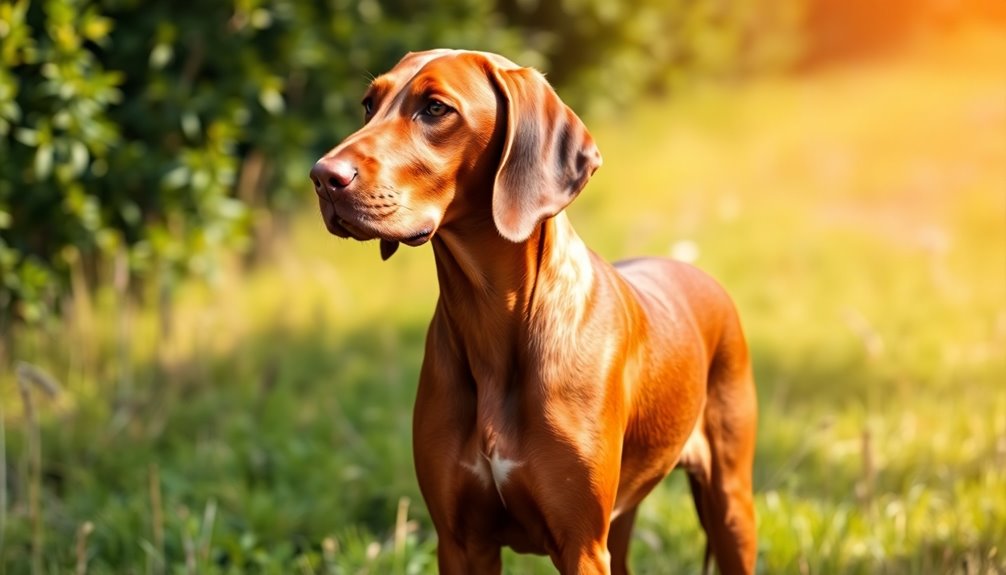
When you consider the health and lifespan of a Redbone Coonhound, you'll notice they typically live between 12 to 15 years. However, they can be prone to certain health issues like hip dysplasia and ear infections, which you should watch for. To keep your Coonhound healthy, focus on regular vet check-ups, a balanced diet, and plenty of exercise. Additionally, being aware of their predisposition to health conditions can help you take proactive measures for their well-being.
Typical lifespan of the breed
The typical lifespan of a Redbone Coonhound ranges from 10 to 15 years, which is impressive for a medium-sized breed. Most large hounds average around 12 years, so the Redbone's longevity is noteworthy.
To maximize your pup's lifespan, focus on proper care, including high-quality food and regular exercise. It's also beneficial to be aware of potential side effects that certain dietary choices may have on their health.
A balanced diet is crucial, as it meets their nutritional needs and helps maintain a healthy weight. Exercise is equally important; these energetic dogs require regular physical activity to thrive. Additionally, socialization needs are essential for their mental well-being, as these dogs thrive on interaction with humans and other animals.
Preventative health measures, such as vaccinations and heartworm medication, play a significant role in keeping your Coonhound healthy.
Monitoring for early signs of health issues and scheduling regular veterinary check-ups can catch potential problems before they escalate.
This breed's muscular frame and active nature contribute to their overall health, as they're typically free from many breed-specific concerns.
However, obesity can shorten their lifespan due to related health issues, so keeping an eye on their weight is essential.
With early training and socialization, you can also prevent behavioral issues, ensuring a happy, long life for your loyal companion.
Common health concerns or genetic predispositions
Common health concerns and genetic predispositions can significantly impact a Redbone Coonhound's overall well-being. One of the most common issues is hip dysplasia, a genetic condition that can lead to arthritis and lameness. You should watch for early signs, like difficulty standing, as treatment may involve X-rays and possibly surgery.
Their floppy ears also make them prone to ear infections, so regular cleaning is essential.
Obesity is another concern since these dogs love food. Maintaining a healthy weight is crucial; overweight dogs can develop arthritis earlier, causing pain and suffering.
Additionally, genetic predispositions like Progressive Retinal Atrophy (PRA) can lead to blindness, while ectropion exposes their eyes to contaminants, leading to irritation. Regular health check-ups are important for monitoring potential health issues that may arise due to genetic factors.
Coonhound paralysis, often triggered by raccoon bites, can cause rapid leg function loss but usually improves with care.
It's wise to consider genetic testing for conditions like PRA to identify carriers before breeding. Regular veterinary check-ups can help detect these health issues early, allowing for timely management and treatment.
Tips for maintaining health and wellness
To help your Redbone Coonhound thrive, maintaining their health and wellness is a top priority. Start by keeping a consistent diet tailored to their age and activity level—avoid giving them people food, and monitor their intake to prevent overeating or undereating. Regular vet visits will help you follow any specific dietary recommendations.
Exercise is essential for your active Coonhound. Aim for moderate to high levels of daily activity with long walks, moderate jogs, or safe off-leash time. Swimming is also a great way to keep them fit, and don't forget to let them sniff around to satisfy their instincts. Always use a leash to prevent them from running off after enticing smells. Regular exercise and a controlled diet are crucial for weight management and preventing obesity.
Grooming plays a big role in their overall health. Brush their coat at least weekly and their teeth twice a week to maintain hygiene. Keep their ears clean and dry, trim their nails regularly, and wash their coat occasionally.
Lastly, supervise your Coonhound like you'd a toddler. Block off areas and keep harmful objects out of reach. Adhere to a vaccination schedule, and consider pet health insurance to cover unexpected medical expenses.
Care Requirements
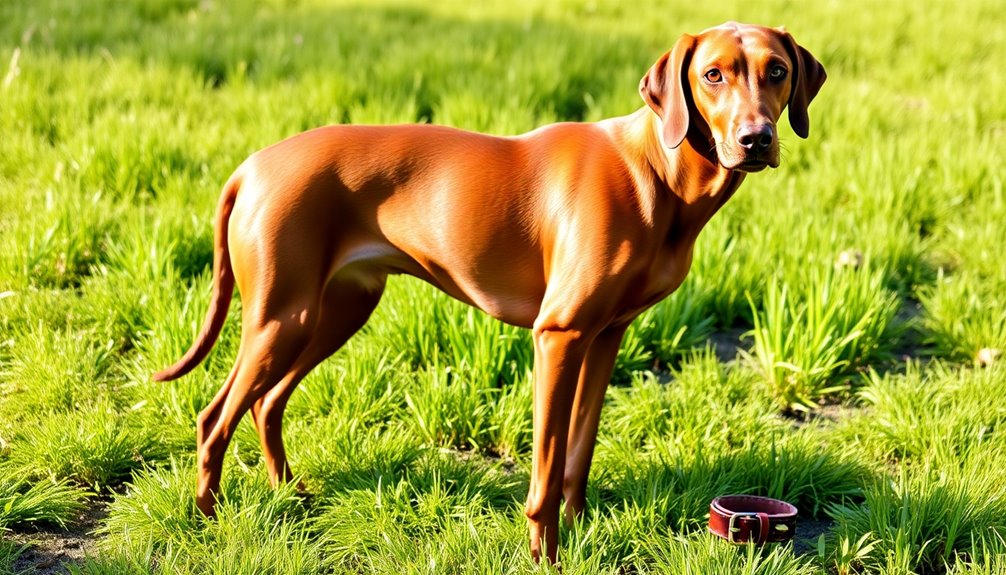
Caring for a Redbone Coonhound involves meeting their exercise needs, maintaining a proper diet, and keeping grooming simple. You'll need to ensure they get plenty of physical activity to match their energetic nature while also providing a balanced diet rich in protein and healthy fats. Regular exercise not only prevents behavioral issues but also satisfies their high energy levels. With minimal grooming required, you can focus on enjoying your time with this loyal and skilled hunter.
Minimal Grooming Required
Grooming your Redbone Coonhound is a straightforward task, thanks to their minimal grooming requirements. You'll only need to brush your dog once or twice a week, using a soft-bristle brush or grooming mitt. This helps remove loose hair and distribute natural oils, keeping the coat sleek and reducing shedding. The short, dense coat makes this a quick and easy process. Regular brushing helps to maintain a sleek appearance of the coat.
Bathing should occur every 2-3 months or as needed, particularly if your dog gets dirty. Use a dog-specific shampoo to maintain skin and coat health, but avoid over-bathing, as it can strip away essential oils. Keep an eye out for any skin irritations, and consult your veterinarian if you notice issues.
Regular ear checks are important to prevent wax buildup and infections; clean your dog's ears with a dog ear cleaner and a soft cloth weekly. Monitor your Coonhound's eyes for irritation and gently wipe away any discharge with a damp cloth.
Don't forget about dental and nail care! Brush their teeth 2-3 times a week and trim nails every few weeks to ensure your Redbone is comfortable and healthy.
Exercise requirements and energy levels
With a high energy level and a strong hunting instinct, your Redbone Coonhound needs plenty of exercise to stay healthy and happy. Aim for 60 to 90 minutes of physical activity each day, combining long walks or runs with interactive play sessions. Off-leash play in a securely fenced area is great for letting your dog explore and burn off energy. Always provide access to water during and after exercise.
Incorporate various types of activities to keep things interesting. Swimming is an excellent form of exercise, while scent games and tracking exercises tap into their natural instincts. Agility training and nose work offer both mental and physical stimulation. Regular physical activity is essential for maintaining their fitness. Additionally, engaging in scent games can provide a fun way to utilize their natural hunting abilities.
Don't forget the importance of mental challenges, too. Regular training sessions help develop their intelligence, and interactive toys can keep them engaged. Socializing with other dogs also provides valuable mental and physical exercise.
Always supervise your Coonhound during playtime, as they may follow interesting scents. Keep safety in mind by ensuring exercise areas are secure and escape-proof.
Monitor for signs of fatigue, especially in younger or health-concerned dogs, to avoid overexertion.
Feeding tips and diet recommendations
Maintaining a healthy diet is just as important as ensuring your Redbone Coonhound gets plenty of exercise. Focus on high-quality protein sources like beef, chicken, turkey, lamb, duck, eggs, and fish. Raw diets can improve gut health and overall vitality, leading to increased energy levels in your dog. Healthy fats are crucial for energy and overall health, so aim for a balance between saturated and unsaturated fats. Incorporate carbohydrates from plant-based sources, such as vegetables and fruits, to provide fiber, prebiotics, and antioxidants.
Feed your adult Redbone Coonhound two meals a day, typically in the morning and evening, while puppies require three to four smaller meals. Stick to a consistent feeding schedule to support their age and activity level. Check AAFCO-approved dog food packaging for portion guidance, but consulting your vet is always wise. Ensure the diet meets AAFCO nutritional standards, using high-quality commercial food formulated for active breeds.
Consider adding supplements like fish oil for skin and coat health, but consult your vet first. Avoid giving human food to maintain a consistent diet, and monitor their weight regularly to keep them healthy. Address any abnormal symptoms with a vet promptly to safeguard your dog's well-being.
Training and Socialization
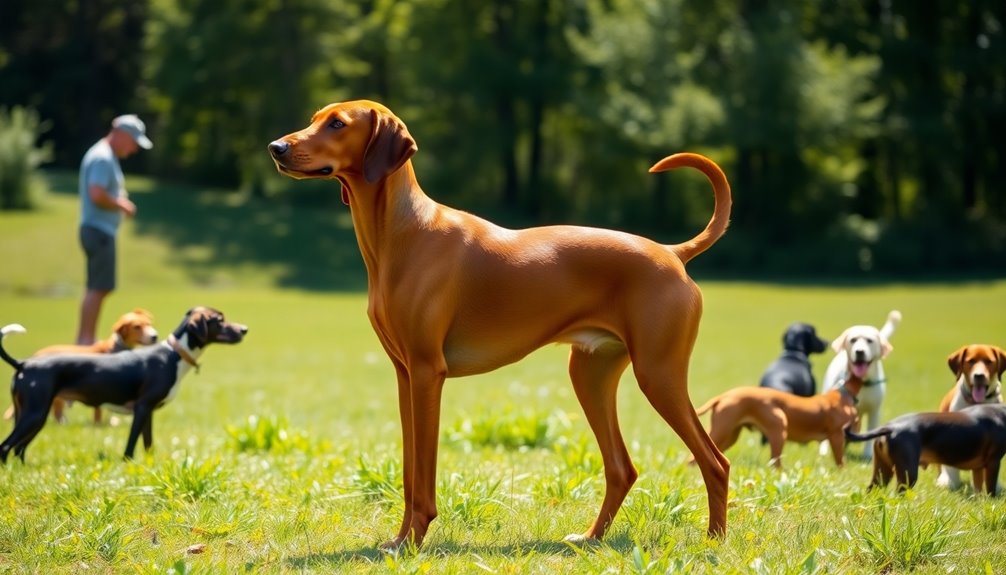
Training your Redbone Coonhound can be a rewarding experience, but it requires patience due to their moderately independent thinking. Gradually introducing them to new environments helps build confidence and reduces leash pulling during walks. Setting clear boundaries fosters respect, which is essential for effective training. With consistent effort, you'll foster a well-behaved companion ready for any adventure.
Moderately Independent Thinker
Some dogs can be a bit more challenging to train, and the Redbone Coonhound is no exception. Their independence and occasional stubbornness can make training tough if you're not ready. To succeed, you'll need patience and a solid understanding of their nature. Consistency is key, so stick to your training plan and be persistent.
Using positive reinforcement is essential. High-value rewards, like treats or praise, can significantly motivate your Redbone during training sessions. Timing is crucial here—reward them immediately after they perform the desired behavior to strengthen the bond between you and your dog while reducing the chances of destructive behaviors. The breed's intelligent and energetic nature means they thrive when engaged in structured activities.
Socialization also plays a vital role in shaping your Coonhound's behavior. Early exposure to various situations and other animals, especially cats, can help them distinguish between normal and threatening scenarios. This reduces anxiety and fear-based behaviors.
Training involves several phases: teaching, practicing, generalizing, testing, and internalizing. Be patient through each stage, and remember to never scold your dog for mistakes. Instead, review your approach and adjust as necessary to ensure your Redbone retains the learned behaviors.
Gradual Introductions to New Environments
Introducing your Redbone Coonhound to new environments can be a gradual process that sets the stage for positive experiences. Start with familiar spaces, like your home and backyard, and introduce small changes, such as new toys or blankets. Use calming music to create a relaxed atmosphere, rewarding calm behavior with treats and praise to reinforce positive associations.
Once your dog is comfortable at home, venture into quieter areas of new environments, such as less crowded sections of parks or pet-friendly stores. Observe your dog's reactions, making adjustments based on their comfort level. Familiar toys or games can help ease the transition, so keep initial outings short and rewarding. It's important to remember that exercise needs are high for Redbone Coonhounds, so incorporating physical activity into these outings can enhance their overall experience.
When you introduce new sounds or surfaces, do so gradually. Start with low volumes and let your dog explore different textures, rewarding them for calm behavior. As your dog gains confidence, gradually increase the complexity of environments.
Always allow your dog to approach new people and other dogs at their own pace, using treats to reinforce positive interactions. This way, you'll help your Redbone Coonhound associate new experiences with rewards, easing their anxiety and building their confidence.
Leash Pulling During Walks
Leash pulling can be a frustrating challenge for you and your Redbone Coonhound during walks, but with the right techniques, you can transform those outings into enjoyable experiences.
Start by using the stopping method: as soon as your dog pulls, stop walking and wait for them to return to a neutral position before proceeding. You can also try leash correction—gently pull up on the leash and release to encourage a relaxed leash.
Changing direction can refocus your dog's attention; if they pull, turn 180 degrees and lead them back in the opposite direction. Positive reinforcement is key, so reward them with treats and praise when they walk politely.
Using a front-attaching harness can help self-correct pulling behavior, while head halters or training collars might be useful alternatives. Additionally, by promoting loose leash walking, you will create a more relaxed environment that benefits both you and your dog.
Remember to keep training sessions short and fun to maintain engagement. Since Redbone Coonhounds are energetic and independent, consistent training and early socialization are crucial.
Ideal Living Environment

To keep your Redbone Coonhound happy and healthy, a spacious, securely fenced backyard is essential. This breed thrives in moderate temperatures year-round, so consider your climate when choosing their living environment. Providing a comfortable space for them to explore and play is key to their well-being. Regular exercise is also important for maintaining their athletic nature.
Spacious Fenced Backyard Needed
For a Redbone Coonhound, a spacious fenced backyard isn't just a luxury—it's a necessity.
These dogs have a strong hunting instinct and will eagerly follow scents, so a securely fenced area is crucial to prevent escapes. A fence height of at least 48 inches is advisable, but keep in mind that some might jump higher. You'll want to ensure your yard is entirely escape-proof to keep your dog from wandering off after intriguing scents.
The yard should allow plenty of room for running and off-leash play, which is essential for their physical and mental well-being. Regular interaction with other dogs can also provide additional socialization opportunities, enhancing their overall experience and well-being.
Incorporating various terrains, like grass and dirt, can mimic their natural hunting environment. Adding interactive elements, such as agility courses or fun hide-and-seek areas, can enrich their experience.
Safety is paramount; always check your fence for gaps or weaknesses and never leave your Redbone unattended in an unfenced yard.
Training them to respond to recall commands is also vital for secure playtime.
Ultimately, a well-utilized yard becomes a perfect playground for your Redbone, fulfilling their exercise needs and keeping them stimulated.
Prefers Moderate Temperatures Year-Round
Redbone Coonhounds thrive best in moderate temperatures, ideally between 60 to 80 degrees Fahrenheit (15 to 27 degrees Celsius). While they can adapt to a wide range of temperatures, you'll want to ensure they're comfortable in their environment.
In colder weather, provide extra protection like dog jackets or sweaters, as their short, dense coat may not offer enough insulation. A well-insulated shelter is essential to prevent hypothermia. Additionally, it's important to recognize that cold weather precautions are crucial for their well-being.
When temperatures rise, these hounds need access to shade and fresh water to avoid heat-related issues. Keep an eye on them during the hottest parts of the day and consider using air conditioning indoors.
Regular grooming helps maintain their coat health, regardless of the climate.
In winter, limit outdoor excursions and monitor for any signs of discomfort or frostbite. You might also need to adjust their diet to provide extra calories during colder months.
Overall, make sure they've well-maintained indoor spaces during extreme weather, and schedule regular vet check-ups to keep them healthy year-round.
Excellent Swimmers and Hunters
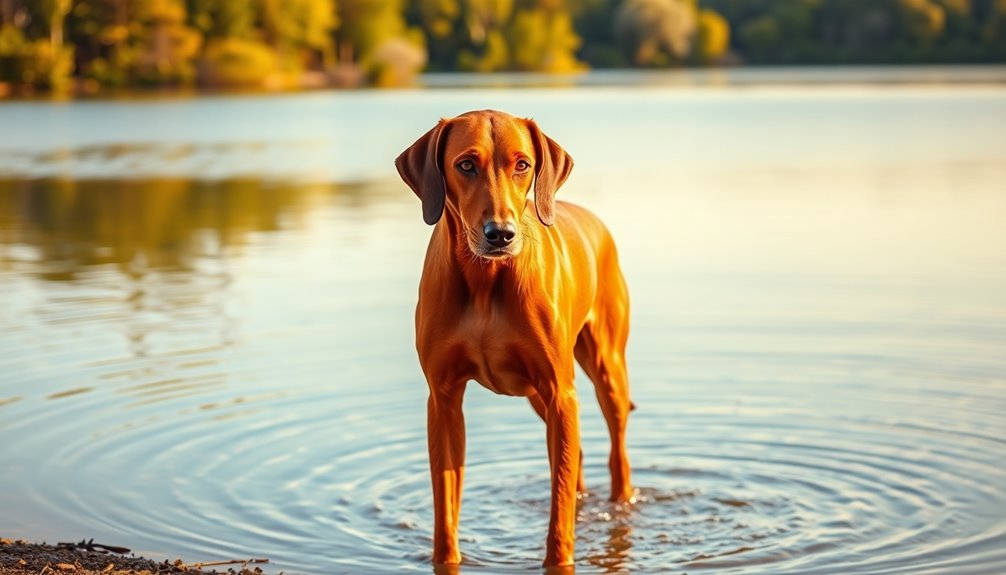
When you think of Redbone Coonhounds, you might picture their impressive hunting skills and natural swimming abilities. These dogs not only excel at tracking down game but also have vocalizations that can mimic other animals, making them even more effective in the field. Additionally, their ability to tree game showcases their specialized hunting traits, further solidifying their reputation as skilled hunters. Plus, their appearance in "The Fox and the Hound" showcases their unique traits, blending their hunting prowess with a touch of charm.
Vocalizations Mimic Other Animals
How do the vocalizations of Redbone Coonhounds enhance their hunting abilities? Their distinctive bay is essential for facilitating communication between you and your dog during hunts. This melodious sound isn't just noise; it acts as a functional tool that helps you track the dog's progress and locate the game. When your Redbone Coonhound finds a scent, its consistent baying serves as a signal, letting you know exactly where the action is happening.
Unlike other breeds that might howl or bark in various situations, the Redbone's vocalizations are primarily used within the context of hunting. Their unique bay sets them apart, making it easy for you to identify when they're on a trail. This clear form of communication allows you to follow along efficiently, ensuring you're always connected to your dog's efforts. Additionally, their vocalizations can carry over long distances, aiding in survival and communication during hunting expeditions. Proper socialization opportunities during their early years can further refine their hunting skills, making them even more effective partners in the field.
While they may vocalize when excited or during play, it's their hunting bay that truly showcases their skills. With their determination and excellent scenting abilities, Redbone Coonhounds rely on their vocalizations to enhance your hunting experience together.
Featured in 'The Fox and the Hound
Featuring prominently in 'The Fox and the Hound,' Redbone Coonhounds are celebrated for their exceptional swimming and hunting skills. Their webbed feet make them natural swimmers, allowing them to navigate various water conditions, from swamps to bayous. To keep their coats in optimal condition after swimming, regular use of Aloe Oatbath Medicated Shampoo is recommended to maintain hygiene and health. Open communication about feelings is essential for their well-being, especially if they are part of a family going through a transition.
While they thrive in water, it's essential to supervise them closely to ensure their safety. If you're teaching them to swim, consider a swim vest for added security.
When it comes to hunting, these dogs shine with their versatility. They can track a wide range of game, from raccoons to cougars, thanks to their remarkable treeing instinct and cold nose, which helps them pick up old trails. Their ability to work in challenging terrain at night gives them an edge as skilled hunters.
To keep your Redbone Coonhound happy and healthy, maintain a daily exercise routine of about an hour to an hour and a half. They love hiking and exploring, so a long leash is a must if they're not trained to stay close.
Ultimately, their exercise often comes from hunting activities, making them both loyal companions and exceptional hunters.
Active Lifestyle Compatibility?
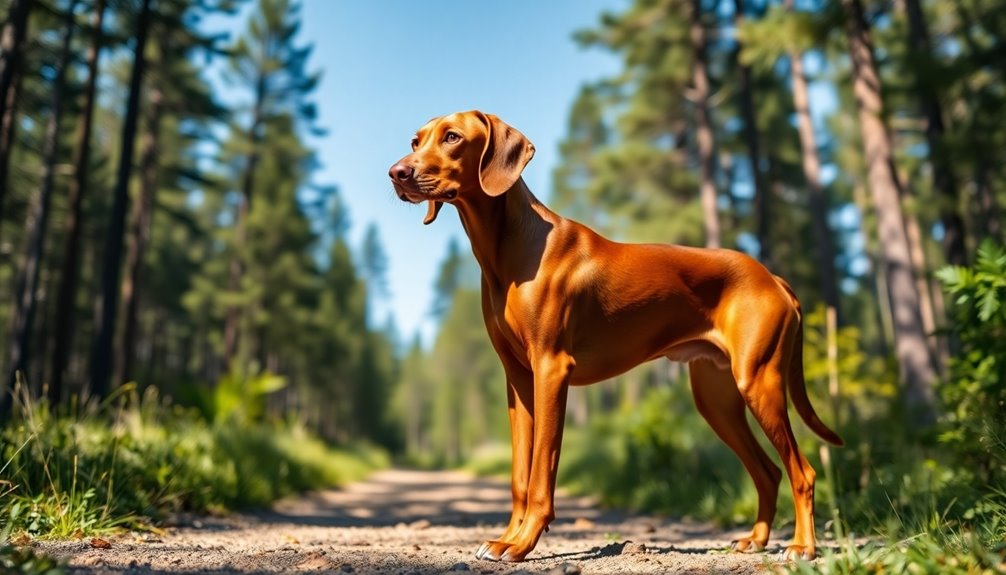
If you lead an active lifestyle, a Redbone Coonhound could be the perfect companion for you. These dogs thrive on physical activity and require engaging exercise to stay happy and healthy. Their exceptional scenting abilities make them great partners for outdoor activities like hiking or tracking. However, you'll need to be mindful of their high prey drive, as they may chase smaller animals during your outdoor adventures.
Ideal for Active Owners
Redbone Coonhounds thrive in active households, making them an ideal companion for owners who love outdoor adventures. If you enjoy running, hiking, or engaging in vigorous play, this breed will keep you on your toes.
These dogs require at least 60 to 90 minutes of exercise daily, so be prepared for long walks, runs, and interactive play sessions. Their high energy levels mean they thrive on variety, so mix up your activities to keep boredom at bay. Regular exercise is essential for their overall health and well-being, as it helps maintain a high vibrational energy that contributes to their happiness.
Taking your Redbone on hikes is especially rewarding; they navigate various terrains with ease. Incorporating agility training or fun games like fetch and tug-of-war helps burn off their abundant energy while providing mental stimulation.
If your yard is securely fenced, letting them play off-leash allows them to explore and use their keen sense of smell.
However, these dogs aren't suited for small living spaces like apartments. They need consistent companionship and socialization, so make sure you're available to engage with them throughout the day.
If you're an active owner ready for a loyal partner, a Redbone Coonhound will fit right into your lifestyle.
High Prey Drive Awareness
Understanding a Redbone Coonhound's high prey drive is essential for anyone considering this breed as an active lifestyle companion. Bred to chase and tree animals like raccoons and bears, these dogs possess a strong hunting instinct that can kick in at any moment.
Once they catch an interesting scent, you'll see their energy surge as they pursue it with intense focus, often going far and fast. This prey drive can be triggered by even minor distractions, like a running squirrel, turning your mild-mannered companion into a determined hunter.
Consequently, keeping your Redbone on a leash or within a fenced area is crucial to prevent them from wandering off and getting into dangerous situations, such as traffic. Their short red coats also make grooming easy, which is an added bonus for active owners who may prefer low-maintenance pets.
Socialization is vital, too; these dogs may not get along with cats or small pets unless introduced to them early. While they're generally friendly with other dogs and strangers, their high energy means supervision around small children is necessary.
To meet their needs, you'll want to commit to at least one to two hours of vigorous exercise daily, incorporating activities like hiking or jogging. Proper management will ensure your Redbone thrives as a loyal and skilled hunting partner.
Frequently Asked Questions
How Much Exercise Does a Redbone Coonhound Need Daily?
A Redbone Coonhound needs 60 to 90 minutes of exercise daily, with at least one to two hours of vigorous activity.
You should include both physical and mental stimulation in their routine to keep them happy and healthy.
Long walks, off-leash play, and interactive games are essential.
Are Redbone Coonhounds Good With Children?
Yes, Redbone Coonhounds are great with children! Their affectionate and gentle nature makes them wonderful family pets.
You'll find they're eager to please, adapting well to various family dynamics. While they've high energy levels, they're playful and can keep older kids entertained.
Just remember to supervise them, especially around toddlers, to ensure everyone stays safe.
With proper training, they'll form a strong bond with your kids, making for a loving household.
What Is the Average Lifespan of a Redbone Coonhound?
The average lifespan of a Redbone Coonhound ranges from 10 to 15 years. Most large hounds tend to live about 12 years, but you can help maximize their lifespan with high-quality food and regular exercise.
Keep up with veterinary care and monitor for common health issues, like ear infections and arthritis. By focusing on their overall well-being, you can ensure your Coonhound enjoys a long, healthy life by your side.
Can Redbone Coonhounds Live in Apartments?
Yes, you can keep a Redbone Coonhound in an apartment, but it requires commitment.
They need at least 60 to 90 minutes of exercise daily, so regular walks and playtime are essential.
Mental stimulation is crucial to prevent boredom, and you'll want to minimize barking to avoid noise complaints.
Ensure they've access to outdoor areas for off-leash play, and provide plenty of companionship to keep them happy and healthy.
Do Redbone Coonhounds Have Any Common Behavioral Issues?
Yes, Redbone Coonhounds can exhibit several common behavioral issues.
You might notice them struggling with housebreaking, ignoring commands, or being destructive when bored. They often bark excessively when left alone and may jump on guests.
If not properly socialized, they could growl or lunge at strangers. Their strong-willed nature can make training a challenge, so consistent supervision and engagement are crucial to prevent these behaviors from becoming problematic.
Conclusion
In conclusion, the Redbone Coonhound is a loyal companion and skilled hunter, perfect for active families or individuals. Their friendly temperament and strong work ethic make them great partners in both the field and at home. With proper training and socialization, they can thrive in various environments, showcasing their natural abilities as excellent swimmers and hunters. If you're ready for an energetic and loving dog, the Redbone Coonhound might just be your ideal match!

